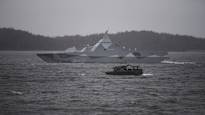The military alliance brings to sea, for example, warships and maritime drones, but does not use military force.
In the coming days, weeks and months, the Baltic Sea will be closely monitored.
The sea is patrolled by warships, submarines, surveillance planes and underwater drones. They are in the places where they are needed, Secretary General Mark Rutte told the Baltic Sea NATO leaders’ meeting in Helsinki. previously reported that up to ten ships will probably participate in the operation.
It is a military operation that targets merchant ships that damage important underwater targets.
1. This is military action, but no force is used
There is no established concept for the operation that NATO launched in the Baltic Sea. It uses warships but no military force. Unlike in military operations, the actual enemy is not clear.
NATO’s operational management ladder Shape decided to launch the operation when the Eagle S was stopped in the Gulf of Finland on suspicion of cutting submarine cables. There are ships on NATO watch duty and ships assigned to the operation by the Baltic Sea countries.
The action that NATO has started now is enhanced presence and vigilance. The measures have been initiated by the decision of the saceur, i.e. the commander of NATO’s European forces, says the head of the defense policy department of the Ministry of Defense Janne Kuusela.
Similar actions were seen in the Baltic Sea at the end of 2023, when the Baltic Connector gas pipeline and data cables were damaged.
A year ago, however, the activities were not nearly on the same scale as they are now.
This time, more noise was also made about the matter: NATO reported on the activities at the summit of the Baltic Sea countries, i.e. effectively used strategic communication.
2. Russia is playing, NATO is looking for answers
Dilapidated merchant ships and tankers, which have dropped their anchors on the seabed, transport Russian oil. So far, no one has been convicted of the accidents, and the actor behind them has not been named.
Violation of energy structures on the seabed has, however, happened before, and in the summer NATO had intelligence information about Russia’s planned sabotage in Europe.
Russia is playing around and guessing where the threshold for using NATO’s defense is. It exploits weak points. According to Tiilikainen, NATO strives to show that there are no weak points, director of the European Competence Center for Countering Hybrid Threats Teija Tiilikainen says.
The Baltic Sea Guard operation described in Helsinki is one deterrent.
3. Sensitivities are made known
The NATO operation, which is not called an operation, is probably already underway in the Baltic Sea. General Secretary Mark Rutte did not give exact details because a potential enemy does not need to know them.
One characteristic of the operation is speed. With a delay of a few days after the first sightings in the Gulf of Finland, NATO convened, discussed and took military action, a researcher at the Foreign Policy Institute Iro Sarkkä says.
NATO works as usual so that it understands the sensitivity of the security situation, says Särkkä.
